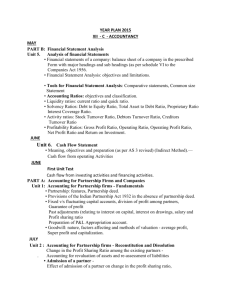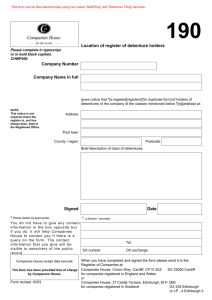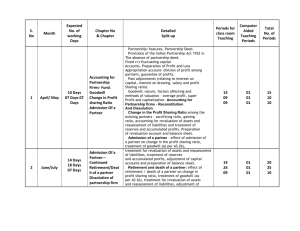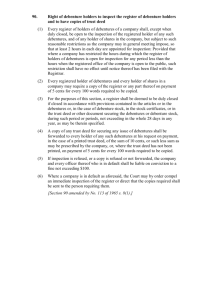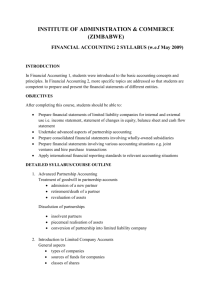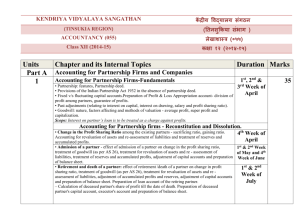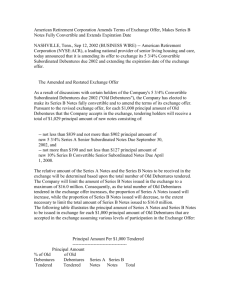Q.1 What are provision relating to governance of – right to share
advertisement
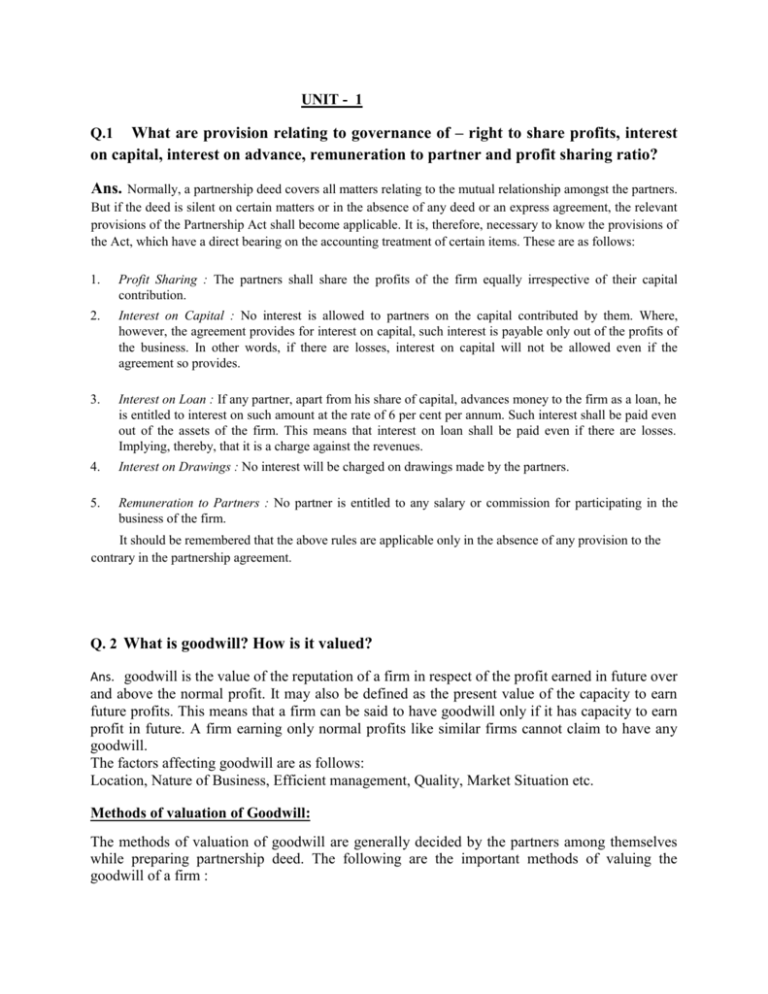
UNIT - 1 What are provision relating to governance of – right to share profits, interest on capital, interest on advance, remuneration to partner and profit sharing ratio? Q.1 Ans. Normally, a partnership deed covers all matters relating to the mutual relationship amongst the partners. But if the deed is silent on certain matters or in the absence of any deed or an express agreement, the relevant provisions of the Partnership Act shall become applicable. It is, therefore, necessary to know the provisions of the Act, which have a direct bearing on the accounting treatment of certain items. These are as follows: 1. Profit Sharing : The partners shall share the profits of the firm equally irrespective of their capital contribution. 2. Interest on Capital : No interest is allowed to partners on the capital contributed by them. Where, however, the agreement provides for interest on capital, such interest is payable only out of the profits of the business. In other words, if there are losses, interest on capital will not be allowed even if the agreement so provides. 3. Interest on Loan : If any partner, apart from his share of capital, advances money to the firm as a loan, he is entitled to interest on such amount at the rate of 6 per cent per annum. Such interest shall be paid even out of the assets of the firm. This means that interest on loan shall be paid even if there are losses. Implying, thereby, that it is a charge against the revenues. 4. Interest on Drawings : No interest will be charged on drawings made by the partners. 5. Remuneration to Partners : No partner is entitled to any salary or commission for participating in the business of the firm. It should be remembered that the above rules are applicable only in the absence of any provision to the contrary in the partnership agreement. Q. 2 What is goodwill? How is it valued? Ans. goodwill is the value of the reputation of a firm in respect of the profit earned in future over and above the normal profit. It may also be defined as the present value of the capacity to earn future profits. This means that a firm can be said to have goodwill only if it has capacity to earn profit in future. A firm earning only normal profits like similar firms cannot claim to have any goodwill. The factors affecting goodwill are as follows: Location, Nature of Business, Efficient management, Quality, Market Situation etc. Methods of valuation of Goodwill: The methods of valuation of goodwill are generally decided by the partners among themselves while preparing partnership deed. The following are the important methods of valuing the goodwill of a firm : (i) Average Profit Method (ii) Super Profit Method (iii) Capitalisation Method Let us learn about these methods. 1. Simple Average Profit Method : Under this method, average of the profits of certain given years is calculated. The value of the goodwill is calculated at an agreed number of years purchase of the average profit. Thus the goodwill is calculated as follows : Value of goodwill = Average Profit × Number of year of purchase 2. Super Profit Method : Super profits is the excess of actual profit over the normal profits. If a new business earns certain percentage of the capital employed, it is called „normal profit‟. The value of the goodwill is calculated at an agreed number of years purchase is multiplied by the Super profit. Normal profit is that profit which is, earned by other business unit of the same business. Normal profit will be calculated as follows: Normal profit = Capital employed × normal rate of return/100 Actual Profit : These are the profit earned during the year or it is also taken as the average of the last few years profit. Super Profit = Actual Profit – Normal Profit 3. Capitalisation Method : In this method, goodwill is the amount of capital saved. Normally businessmen invest capital to operate business activities, and earn profit with the efficient utilisation of capital. If the business earns more profit by investing lesser amount of capital as compared to other business, who earned same amount of profit with more amount of capital, the saved amount is assumed to be goodwill. Under this method, the Goodwill is calculated in two ways: 1. Capitalisation of Average profit 2. Capitalisation of Super profit Capitalisation of Average profit In this method, the value of goodwill is assumed to be excess of the capital value of average profit over the actual capital employed. Following formula is applied for Calculation of capital employed: Capital employed = Total assets – outsider liabilities Following formula is applied for calculation of capitalised value of profit: Capitalised value of profit = Average Profit × 100/ Normal rate of profit Goodwill = Capitalised value of profits – Capital cimployed Capitalisation of Super profit In this method, the value of goodwill is calculated on the basis of super profit method. Following formula is applied for Calculation of capital employed: Goodwill = Super profit × 100/normal rate of profit Q. 3 Why assets and liabilities are revalued on admission of a partner? Give imaginary covering such revaluation. Ans. On admission of a new partner, the firm stands reconstituted and consequently the assets are revalued and liabilities are reassessed. It is necessary to show the true position of the firm at the time of admission of a new partner. If the values of the assets are raised, gain will increase the capital of the existing partners. Similarly, any decrease in the value of assets, i.e. loss will decrease the capital of the existing partners. For this purpose a„Revaluation Account‟ is prepared. This account is credited with all increases in the valueof assets and decrease in the value of liabilities. It is debited with decrease on account of value of assets and increase in the value of liabilities. The balance of this account shows a gain or loss on revaluation which is transferred to the existing partner‟s capital account in existing profit sharing ratio. journal entries made for this purpose are: (i) For increase in the value of assets: Asset A/c Dr. (individually) To Revaluation A/c (ii) For decrease in the value of Asset Revaluation A/c Dr. (individually) To Asset A/c [Decrease in the value of assets] (iii) For increase in the value of Liabilities: Revaluation A/c Dr. (individually) To Liabilities A/c [Increase in the value of Liabilities] (iv) For decrease in the value of Liabilities: Liabilities A/c Dr. To Revaluation A/c [Decrease in the value of Liabilities] (v) For unrecorded Assets Asset A/c [unrecorded] Dr. To Revaluation A/c [Unrecorded asset recorded at actual value] (vi) For unrecorded Liability : Revaluation A/c Dr. To Liability A/c [unrecorded] [Unrecorded Liability recorded at actual value] (vii) For transfer of gain on revaluation: Revaluation A/c Dr. To Existing Partner‟s Capital/Current A/c [Profit on revaluation transferred to capital account in existing ratio] (viii)For transfer of loss on revaluation: Existing Partner‟s Capital/Current A/c Dr. To Revaluation A/c [Loss on revaluation transferred to capital account in existing ratio] Proforma of Revaluation account is given as under: Revaluation account Dr. Cr. Particulars Amount (Rs.) Particulars Amount (Rs.) Assets Assets [decrease in value] [Increase in value] Liabilities Liabilities [increase in value] [Decrease in value] Liabilities[unrecordcd] Assets [unrecorded] Profit transferred to Loss transferred to Capital A/c Capital A/c [Individually in existing ratio] [Individually in existing ratio] Que.4 Differentiate between dissolution of firm and dissolution of partnership. Ans. Basis Dissolution of Partnership Termination of business No, the business is not terminated. Settlement of assets and liabilities Assets and revalued and Dissolution of Firm The business of the firm is closed. liabilities are Assets are sold and realized new balance and liabilities are paid off. sheet is drawn. Court’s Intervention Court does not intervene A firm can be dissolved by because partnership is the court’s order. dissolved by mutual agreement and through the process of reconstitution. Economic RelationShip Economic relationship may remain and changes. Economic relationship between the partners comes to an end. Closure of books Does not require because the business is not terminated. All books of accounts are closed. Give the accounting treatment of goodwill in case of retirement when goodwill already appearing in the books of accounts and when goodwill doesnot appears in the books of accounts. Q. 5 Ans. The retiring partner is entitled to his/her share of goodwill at the time of retirement because the goodwill is the result of the efforts of all partners including the retiring one in the past. The retiring partner is compensated for his/her share of goodwill. As per Accounting Standard 10 (AS-10), goodwill is recorded in the books only when some consideration in money is paid for it. Therefore, goodwill is recorded in the books only when it is purchased and the goodwill account cannot be raised on its own. When the Goodwill Account does not appears in the Books In case of retirement of a partner, the goodwill is adjusted through partner‟s capital accounts. The retiring partner‟s capital account is credited with. his/her share of goodwill and remaining partner‟s capital account is debited in their gaining ratio. The journal entry is made as under: Remaining Partners‟ Capital A/c Dr. (individually) To Retiring Partner‟s Capital A/c (Retiring partner‟s share of goodwill adjusted to remaining partners in the gaining ratio) When the Goodwill Account already appears in the Books Normally the goodwill is not shown in the books of the firm. If at the time of retirement/death of a partner, goodwill appears in the Balance Sheet of the firm, it will be written off by debiting all the partners‟ capital account in their existing profit sharing ratio and crediting the goodwill account. In such a case, the following journal entry is made: Partners‟ Capital A/c Dr (including retiring partner‟s capital A/c) To Goodwill A/c (Existing goodwill written-off) Q. 6 What are the amounts payable to executor of a deceased partner? Ans. On the death of a partner, the accounting treatment regarding goodwill, revaluation of assets and reassessment of liabilities, accumulated reserves and undistributed profit are similar to that of the retirement of a partner, When the partner dies the amount payable to him/her is paid to his/her legal representatives. The representatives are entitled to the followings : (a) The amount standing to the credit to the capital account of the deceased partner (b) Interest on capital, if provided in the partnership deed upto the date of death: (c) Share of goodwill of the firm; (d) Share of undistributed profit or reserves; (e) Share of profit on the revaluation of assets and liabilities; (f) Share of profit upto the date of death; (g) Share of Joint Life Policy. The following amounts are debited to the account of the deceased partner‟s legal representatives: (i) Drawings (ii) Interest on drawings (iii) Share of loss on the revaluation of assets and liabilities; (iv) Share of loss that have occurred till the date of his/her death. The above adjustments are made in the capital account of the deceased partner and then the balance in the capital account is transferred to an account opened in the name of his/her executor. The payment of the amount of the deceased partner depends on the agreement. In the absence of an agreement, the legal representative of a deceased partner is entitled to interest @ 6% p.a. on the amount due from the date of death till the date of final payment. UNIT - 2 Q. 7 What is meant by over subscription of shares? What accounting treatment is given to the amount over subscribed? Ans. When company receives applications for more number of shares than the number of shares offered to the public for subscription it is a case of over subscription. A company cannot allot more shares than what it has offered. In case of over subscription, company has the following options : Option I (i) Rejection of Excess Applications and Money Returned The company may reject the applications for shares in excess of the shares offered for issue and a letter of rejection is sent to such applicants. In this case the application money received from these applicants is refunded to them in full. The journal entry made is as follows: Share Application A/c Dr To Bank A/c (Application money on … shares refunded to the applicants) (ii) Excess application money adjusted towards sums due on allotment. Journal entry made is : Shares Application A/c Dr To Share Allotment A/c (Excess application money adjusted towards sums due on allotment) If the application money received on partially accepted applications is more than the amount required for adjustment towards allotment money, the excess money is refunded. However, if the Articles of the company so authorise, the directors may retain the excess money as calls in advance to be adjusted against the call/calls falling due later on and the following entry is made : Share Application A/c Dr To Call-in-advance A/c (The adjustment of excess share application money retained as call-in-advance in respect of ... shares). Option II Partial acceptance of Applications. In some cases the company accepts the applications for subscription partially. It means that the company does not allot the full number of shares applied for. For example if an applicant has applied for 5000 shares and is allotted only 2000 shares, then the applications is said to have been partially accepted. The company may evolve some formula of accepting applications partially or making proportionate allotment/ the Prorata allotment which means that the applicants are allotted shares proportionately. In such a case the company adjusts the excess share money received on application towards share allotment money due on partially accepted applications. The journal entry recording the adjustment of application money towards share allotment money, is as under : Share Application A/c Dr To Share Allotment A/c (Share application money transferred to Share Allotment Account in respect of ... shares). Q.8 What do you mean by debenture? State in brief the various types of debentures. Ans. As per section 2(12) of Companies Act 1956, “Debenture includes debenture stock, bond and any other securities of the company whether constituting a charge on the company‟s assets or not”. Types of debentures Debenture can be classified as under : 1. From security point of view (i) Secured or Mortgage debentures : These are the debentures that are secured by a charge on the assets of the company. These are also called mortgage debentures. The holders of secured debentures have the right to recover their principal amount with the unpaid amount of interest on such debentures out of the assets mortgaged by the company. In India, debentures must be secured. Secured debentures can be of two types : (a) First mortgage debentures : The holders of such debentures have a first claim on the assets charged. (b) Second mortgage debentures : The holders of such debentures have a second claim on the assets charged. (ii) Unsecured debentures : Debentures which do not carry any security with regard to the principal amount or unpaid interest are called unsecured debentures. These are called simple debentures. 2. On the basis of redemption (i) Redeemable debentures : These are the debentures which are issued for a fixed period. The principal amount of such debentures is paid off to the debenture holders on the expiry of such period. These can be redeemed by annual drawings or by purchasing from the open market. (ii) Non-redeemable debentures : These are the debentures which are not redeemed in the life time of the company. Such debentures are paid back only when the company goes into liquidation. 3. On the basis of Records (i) Registered debentures : These are the debentures that are registered with the company. The amount of such debentures is payable only to those debenture holders whose name appears in the register of the company. (ii) Bearer debentures : These are the debentures which are not recorded in a register of the company. Such debentures are transferrable merely by delivery. Holder of these debentures is entitled to get the interest. 4. On the basis of convertibility (i) Convertible debentures : These are the debentures that can be converted into shares of the company on the expiry of predecided period. The term and conditions of conversion are generally announced at the time of issue of debentures. (ii) Non-convertible debentures : The debenture holders of such debentures cannot convert their debentures into shares of the company. 5. On the basis of priority (i) First debentures : These debentures are redeemed before other debentures. (ii) Second debentures : These debentures are redeemed after the redemption of first debentures. Q. 9 Write and explain the accounting treatment of various forms in which debentures can be issued. Issue of Debenture takes various forms which are as under : 1. Debentures issued for cash 2. Debentures issued for consideration other than cash 3. Debentures issued as collateral security. Further, debentures may be issued (i) at par, (ii) at premium, and (iii) at discount 1. Accounting treatment of issue of debentures for cash A. Debentures issued for cash at par : Following journal entries will be made : (i) Application money is received Bank A/c To Debentures Application A/c Dr (Application money received for Debentures) (ii) Transfer of debentures application money to debentures account on their allotment Debentures Application A/c Dr To Debentures A/c (Application money transferred to debenture account on allotment) (iii) Money due on allotment Debentures Allotment A/c Dr To Debentures A/c (Allotment money made due) (iv) Money due on allotment is received Bank A/c Dr To Debentures Allotment A/c (Receipt of Debenture allotment money) (v) First and final call is made Debentures First and Final call A/c Dr To Debentures A/c (First and Final call money made due on ............... debentures) (vi) Debentures First and Final call money is received Bank A/c Dr To Debentures First and Final call A/c (Receipt of Amount due on call) Note : Two calls i.e. first call and second call may be made Journal entries will be made on the lines made for first and final call. B. Issue of Debentures at Discount When debentures are issued at less than their nominal value they are said to be issued at discount. For example, debenture of Rs 100 each is issued at Rs 90 per debenture. Companies Act, 1956 has not laid down any conditions for the issue of debentures at a discount as have been laid down in case of issue of shares at discount. However, there should be provision for issue of such debentures in the Articles of Association of the Company. Journal entry for issue of debentures at discount (at the time of allotment) Debentures Allotment A/c Dr Discount on issue of debentures A/c Dr To Debentures A/c (Allotment money due. The amount of discount is @ Rs .... per debenture) C. Issue of Debentures at Premium The premium on the issue of debentures is credited to the Securities Premium A/c as per section 78 of the Companies Act, 1956. Journal entry will be as follows : Debentures Allotment A/c Dr To Debentures Account To Securities Premium A/c (Amount due on allotment alongwith premium of Rs ....) 2. Issue of Debentures for consideration other than cash When a company purchases some assets and issues debentures as a payment for the purchase, to the vendors it is known as issue of debentures for consideration other than cash. Debentures can be issued to vendors at par, at premium and at discount Accounting Treatment : 1. Purchase of Assets Sundry Assets A/c Dr (Individually) To Vendors A/c (Purchase of assets) 2. Allotment of debentures (i) At par Vendors' A/c Dr To Debentures A/c (issue of debentures at par to vendors) (ii) At discount Vendors' A/c Dr Debentures Discount A/c Dr To Debentures A/c (Issue of debentures to vendors at a discount of Rs ... per debenture (iii) At premium Vendors‟ A/c To Debentures A/c To Securities Premium A/c (issue of debentures to vendors at a premium of Rs .... per debenture) 3. Issue of Debenture as collateral security: Collateral security means security given in addition to the principal security. It is a subsidiary or secondary security. Whenever a company takes loan from bank or any financial institution it may issue its debentures as secondary security which is in addition to the principal security. Such an issue of debentures is known as „issue of debentures as collateral security‟. The lender will have a right over such debentures only when company fails to pay the loan amount and the principal security is exhausted. In case the need to exercise this right does not arise debentures will be returned back to the company. No interest is paid on the debentures issued as collateral security because company pays interest on loan. In the accounting books of the company issue of debentures as collateral security can be credited in two ways. (i) No journal entry to be made in the books of accounts of the company : Debentures are issued as collateral security. A note of this fact is given on the liability side of the balance sheet under the heading Secured Loans and Advances. Balance Sheet ...... Co. Ltd. Capital & liabilities Amount Rs Assets Rs Debentures (.... debentures of Rs .... per debenture issued as collateral security Loan (Secured by the issue of .... debentures of Rs .... each issued as collateral security (ii) Entry to be made in the books of account the company Amount Rs A journal entry is made on the issue of debentures as a collateral security, Debentures suspense A/c is debited because no cash is received for such issue. Following journal entry will be made Debenture Suspense A/c Dr To Debentures A/c (.....Debentures of Rs .... each issued as collateral security to ..... ) In the Balance sheet of the issuing company it will be shown as udner : Balance Sheet of ...... Co. Ltd. Capital & Liabilities Amount Rs Assets Rs Amount Rs Bank Debenture Debenture suspense A/c (.....debenture of Rs .... each issued as collateral security as per contra) (Debenture issued as collateral security for loan as per contra) Loan Q. 10 What is profit and loss appropriation account? How is it prepared? State the items to be recorded in p& l appropriation account. Ans. A company has to prepare the Profit and Loss Appropriation Account in addition to the profit and loss account. It shows the appropriation of Profit and is popularly known as below the line the splitting of the Profit and Loss A/C into three section (i.e. trading A/C, Profit and loss A/C and profit and loss appropriation A/C) is not forbidden by the companies Act. It is desirable to split the profit and loss A/C into three sections so that gross profit, Net profit and surplus carried to the balance sheet may be ascertained. It is prepared as follows: Profit and loss appropriation Account Dr Cr Particulars To Transfer to Reserves Amount (Rs) Xxxxx Particulars By Last year’s Balance b/d Amount (Rs) Xxxxx To Income tax for Previous Year not provided for To Interim dividend By Net Profit for the year Xxxxx By Amount withdrawn from Xxxxx General Reserve/other To Surplus (balancing figure carried to Balance Sheet) reserve Xxxxx Xxxxx By Provision( Income tax provision not required) xxxxx Xxxxx Xxxxx xxxxx
